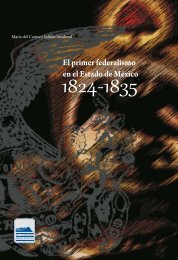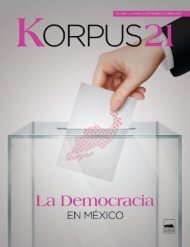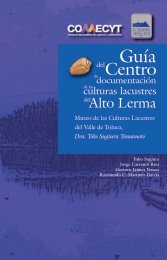Create successful ePaper yourself
Turn your PDF publications into a flip-book with our unique Google optimized e-Paper software.
MARY KAY VAUGHAN, EDUCATING THE SENSES: PEPE ZÚÑIGA AND MEXICO CITY’S REBEL GENERATION<br />
in Mexico City. Pepe recalled the smell of cedar<br />
wafting from the carpenter’s shop on his<br />
walk to school with his mother. In our walks in<br />
the Guerrero, we stopped and talked at length<br />
with those who had once been playmates. They<br />
shared memories about Christmas celebrations,<br />
street games, and learning to dance. We walked<br />
by his primary school and the church of Santa<br />
María la Redonda, one of the oldest in Mexico.<br />
We stopped in the church and sat in the pews<br />
where he shared his thoughts about the saints,<br />
the priest and his first communion. We walked<br />
on to the Plaza Garibaldi where the family had<br />
enjoyed so much entertainment—the mariachi<br />
bands, Pérez Prado’s mambo, Tongolele’s exotic<br />
dancing, Maria Luisa Landin’s boleros. We<br />
entered the Tenampa Bar, took a table and recalled<br />
the stories we had heard of the legendary<br />
José Alfredo Jimenez and Chavela Vargas singing<br />
ballads as they drank till dawn. To arrive at<br />
a notion of how distinct were Pepe’s memories<br />
and what made them so, I interviewed his brothers<br />
and his cousins. Indeed, they differed in their<br />
interpretations of the same events. We explored<br />
why that was.<br />
My framework borrowed from Elias and<br />
fleshed out by further information on social and<br />
economic change in Mexico City from the 1940s<br />
into the 1960s gave me an argument for assuming<br />
some shared experience across a somewhat<br />
circumscribed, yet broad sector of children and<br />
youth. I became convinced that while most children<br />
able to do so shared a very solid formation<br />
in formal education, the education of the senses<br />
derived primarily from their shared experiences<br />
with the mass media: especially radio, film, and<br />
cinema (later theater) and the conditions in<br />
which they experienced them. In what follows<br />
I explain how this media inquiry undertaken by<br />
Pepe and me in our exploration of self and our<br />
times through multiple macro and micro forms<br />
of knowing.<br />
Norbert Elias (b 1897) had written about<br />
youth´s sense of justice, self-development, and<br />
freedom but he had little to say about the media<br />
or the senses. His contemporaries Frankfurt<br />
School theoreticians, Theodor Adorno (b. 1903)<br />
and Max Horkheimer (b 1895), abhorred it as a<br />
product of capitalism complicit in the rise of fascism<br />
(Adorno and Horkheimer, 1979). Sociologist<br />
Oscar Lewis (b. 1914) studying the neighborhood<br />
of Tepito next-door to the Colonia Guerrero, noted<br />
the Sánchez children he researched were constantly<br />
at the movies, but he said nothing about<br />
what they saw or thought about them (Lewis,<br />
2011). Jurgen Habermas (b. 1929), younger scion<br />
of the Frankfurt school, wrote of the critical<br />
role of political opinion in the press and radio but<br />
said nothing about music or fiction as these were<br />
about feeling, not rationality (Habermas, 1992).<br />
Emotion for Habermas was bound up with the<br />
excesses of Nazism. Nonetheless, Habermas’ recognition<br />
of the importance of press and radio—of<br />
‘public opinion’--contributed to opening the way<br />
for me to a deeper appreciation of emotion’s historical<br />
importance. For me and scholars far more<br />
astute and learned than I, emotive expression became<br />
essential to public sphere analysis. Miriam<br />
Hansen (1949), among other investigators of the<br />
mass media, cinema and cultural studies, drew on<br />
the ambivalent, suggestive German film scholars,<br />
Siegfried Kracauer (1889) and Walter Benjamin<br />
(1892) (Hansen, 2012; Hansen, 2000). Her work<br />
helped me to appreciate how the technologies<br />
of photography, cinema, radio, and recording effected<br />
sensorial and affective revolutions while<br />
fostering the creation of new communities at<br />
the local, national, and transnational levels. The<br />
media created links of empathy and mutual recognition<br />
that broke barriers and formed the basis<br />
for social and political discussion. 1 In making<br />
private life public, they created and broadcast<br />
discourses, practices, and sentiments that facilitated<br />
the necessary negotiation of processes of<br />
modernization: migration, urbanization, mobility,<br />
employment, family life, romance, fashion, consumption,<br />
and gender roles. From the 1930s until<br />
the end of the 1950s, most media were censored<br />
and didactic. The public both saw themselves in<br />
and modeled themselves after the media. If the<br />
public responded pathologically to fascist messaging<br />
in Germany, I came to see the Mexican<br />
media I explored with Pepe as purposely benign.<br />
Mexican radio prohibited discussions of politics,<br />
religion, or sex. Instead, the airwaves filled with<br />
music, melodrama, advice shows, and sports. In<br />
Mexico, this censorship created an opening for<br />
shaping the senses in particular ways. In effect,<br />
the mass media operated as the soft power of<br />
the state: creating subtle affective links between<br />
strangers separated by class, spatial distance,<br />
1 On radio and community creation, see Loviglio (2005).<br />
116



![bicentenario_1[V2]](https://img.yumpu.com/68677971/1/167x260/bicentenario-1v2.jpg?quality=85)
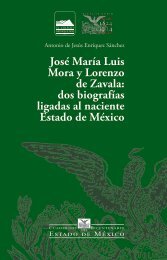
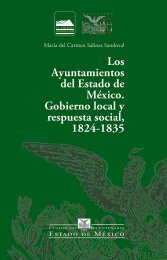

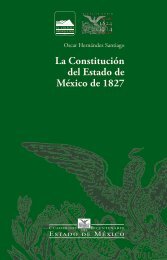
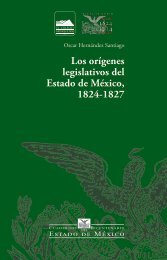
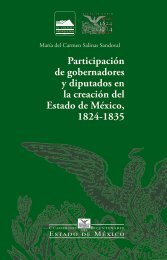
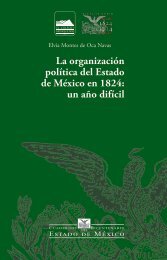
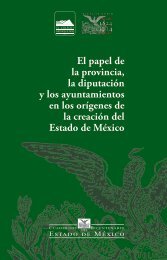
![El_primer_federalismoEM[final]_compressed (2)](https://img.yumpu.com/68483279/1/178x260/el-primer-federalismoemfinal-compressed-2.jpg?quality=85)
